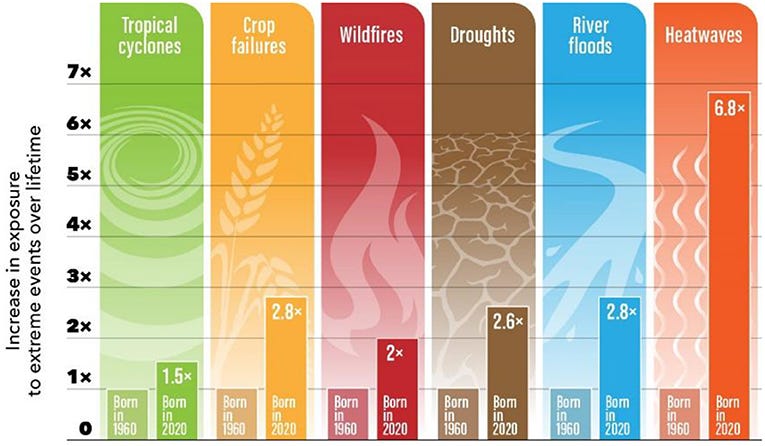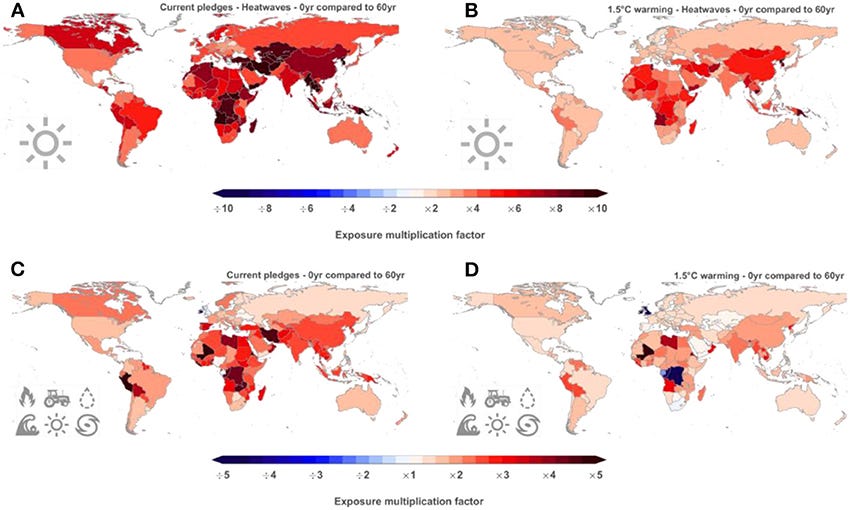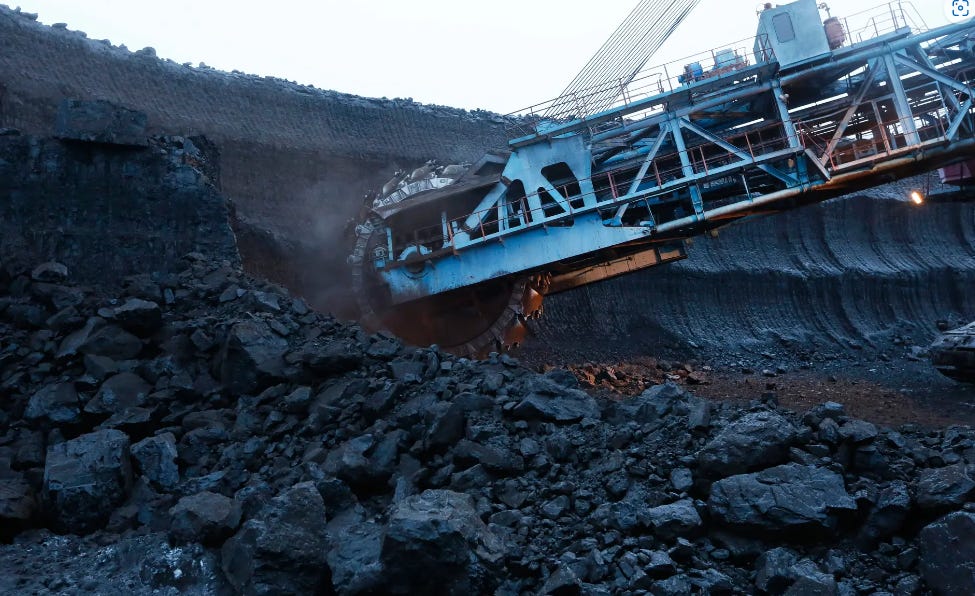India literally had tires melt on the roads since (at least) 8 days ago. In India, the effect of ambient temperature fluctuation on tyre air pressure is most evident in the northern region as both winters and the summers, the temperatures are extreme. In summers, the temperatures can reach up to (extreme hot) 45 degree Celsius, while in winters, the temperatures can drop to 3 degree Celsius. Generally, for every 12 degree Celsius change in the ambient temperature, the tyre pressure changes by 2 per cent (up with higher temperatures and down with lower). Most of the car manufacturers recommend tyre air pressure in the range of 30-35 psi therefore, a change of 12 degree Celsius will change the tyre pressure by 1 psi. You can put together the rest of the equation yourself.
The heat across most of Asia for April is insanely hot. The severity of climate change is being witnessed today- not 20-30 years into the future. Action on climate adaptation and mitigation is urgent.
One in three people on the planet is being hit by this “anomaly-extreme” Asian heatwave. Temperature records for April have been smashed in many places. This is not some anomaly. This is a very dangerous recent warming trend being witnessed.
Millions in this region of the world don’t have access to Air-conditioning - and even that can’t protect you if the electricity fails. As heatwaves get worse, the grid will go down. weather in Jakarta at this moment is indeed hot. The air even flows into the rooms during the day, making us feel like we are on the seashore.
In facing the hot temperatures, the public should increase their water intake, maintain a healthy diet and eat more fruit to avoid dehydration and becoming susceptible to disease. Don’t forget to wear nose shields or masks to block out dust, to wear proper clothing and to apply sunscreen as well as to bring an umbrella whenever taking part in activities outdoors to protect our skin from direct sunlight. The Meteorology, Climatology and Geophysics Agency (BMKG) previously issued warnings that Indonesia would be exposed to hot temperatures until end of April 2023.
A 2013 study by Prof Clark, Prof Mix, Prof Shakun and Associate Professor Shaun Marcott, reconstructed global mean surface temperatures and found that temperatures today are “higher than those during 90 per cent of the entire Holocene.”
A 2020 study, co-authored by Prof Kaufman, found that the warmest 200-year period of the Holocene before industrialisation took place around 6500 years ago when global surface temperatures were about 0.7 degrees Celsius warmer than in the 19th century.
During the period between 2011 and 2019, however, temperatures averaged 1C higher than the 19th century, which brings recent temperatures above that of the entire Holocene.
In a 2022 technical note by Prof Kaufman, he concluded that “human-caused global warming is now exceeding the warmest multi-century period of the Holocene and thereby the envelope of temperatures under which agriculturally based society has flourished”.
A 2021 study reconstructed global mean surface temperatures over the past 24,000 years. Although its methods and some of its findings differed from previous studies, it still found that the global average surface temperature in recent years surpassed those of the past 24,000 years.
Prof Shakun agreed the claim was false and said the “1.2 (degrees Celsius) of recent warming makes the world warmer now than it has been for the vast majority, if not the entirety, of the past 10,000 years”.
oth climate scientists and the public that the world’s weather patterns are changing due to human-caused climate change
Long-term changes in Earth’s weather patterns.
. Do you ever worry that adults are not doing enough to protect the planet, so that younger generations will have a safe and healthy world in which to grow up and raise their own children? Youth climate advocates like Greta Thunberg are speaking out strongly about the need to protect the planet for future generations by taking bigger stepsnowto combat the climate crisis, and thankfully the world is starting to listen.
When we talk about the climate crisis, we most often mean global warming
—the increasing temperatures caused by the greenhouse gases produced by burningfossil fuels
Oil, coal, and gas, which are burned to produce electricity, heat buildings, or drive vehicles.
like oil, coal, and gas. Average global temperatures have already risen around 1°C sincepre-industrial
The period before the Industrial Revolution, when the climate was around 1°C colder than today. This period is often used as a reference by climate scientists to assess climate change.
times (1850–1900) [1]. If all the world’s countries keep fighting climate changeat the same level they are today, by 2100 the median global temperature increase will be around 2.7°C. At the meeting of theUnited Nations Climate Change Conferencein November 2021, countries promised to do more. But even if all participating countries follow through on theircurrent pledges
The actions that countries around the world promise to take by 2030, to combat climate change. If these promises are fulfilled, we will end up with around 2.4°C of warming by 2100.
to reduce greenhouse gas production, the estimated median temperature rise isstill estimated to be around 2.4°C.
While a few degrees of temperature rise might not sound like much, climate scientists know that this change will have serious consequences: sea-level rise, destruction of habitats, and changes in weather patterns. Climate scientists are convinced that rising global temperatures are linked to the increasing number and intensity of severe weather events that you might have seen on the news, including not only heatwaves and wildfires, but droughts, crop failures, river floods, and severe wind and rainstorms called tropical cyclones [2, 3]. Extreme weather can have many dangerous consequences. For example, wildfires and floods can directly injure or even kill people and can cause extensive damage to property. If crops die from drought or flood, food prices can increase, and food shortages (and even starvation) could result. Floods can contaminate drinking water with dangerous bacteria that could make people sick. If an extreme weather event damages the power grid and electricity is down for a long time, hospitals and other critical services could suffer and many lives could be lost (for more information on extreme weather and climate change, click here).
What Makes This Study Special?
Since both warmer temperatures and the extreme climate events associated with them are increasing, it seems obvious that a child born today will experience more climate extremes
than a 60-year-old. But how much more? Until we performed our study, climate scientists were good at comparing two time periods to predict, for example, how heatwaves will change between now and 2100 how many there might be, how hot they might be, and how long they might last. However, these scientists typically didnotlook at the issue from the point of view of individuals…what does climate change mean for a specific person born in a specific place in a specific year?
Our study is special because we determined how many extreme climate events a real person in a real location will face across their entire lifetime, depending on the year they were born and their life expectancy. The results of our study are the first to predict, for example, how likely a person is, over the course of their lifetime, to experience extreme heatwaves (the kind that would only occur once every 100 years in a world without human-caused climate change) or other climate extremes.
We made two main kinds of comparisons. First, we compared average lifetime exposures of younger generations to the average lifetime exposure of a 60-year-old person, under a range of possible warming scenarios. For example, how many more heatwaves would a child born in 2020 face during their lifetime than would be faced by a person who is currently 60 years old, over their entire lifetime? Second, we compared the average lifetime exposure of people living now to that of people living under pre-industrial climate conditions. For example, how would the number of heatwaves experienced by a 6-year-old born in 2020 compare to that of someone living in a world without human-caused climate change?
In addition to heatwaves, we also looked at lifetime exposure to other climate extremes, including droughts, crop failures, river floods, tropical cyclones, and wildfires.
Results: Comparing Generations
Under current pledges, which would bring global warming to 2.4°C by 2100, our results show that children will face many more extreme climate events during their lifetimes than the average 60-year-old person will face, and that this is especially true in low-income countries (see below). On average, babies born across the globe in 2020 will face around seven times more scorching heatwaves during their lives than a person born in 1960—someone of their grandparents’ generation. While heatwaves might not sound like a big deal, they are actually silent killers that cause many fatalities. The 2003 heatwave in Europe caused 70,000 deaths, for example. In addition to heatwaves, babies born in 2020 will, on average, live through 2.6 times more droughts, 2.8 times more river floods, 1.5 times more tropical cyclones, almost 3 times more crop failures, and 2 times the number of wildfires as people born 60 years ago (Figure 1).

Results: Comparing to Pre-Industrial Times
While comparing generations against each other can give us interesting information, it does not account for the fact that people born in 1960 are already facing increasing weather extremes. We just have to look at the recent news to see that such extremes are currently happening across the world. For this reason, we also decided to compare the lifetime extreme event exposures
of people living today to imaginary people living in a pre-industrial climate before humans did things to increase global warming. We also extended the upper limit of warming in our study, because it is not at all certain that current climate pledges will be met…and even if they are, they may not be enough to slow warming to 2.4°C.
If 3°C of global warming occurs by 2100, a child who was 6 years old in 2020 will experience 2 times more wildfires and tropical cyclones, 3 times more river floods, 4 times more crop failures, 5 times more droughts, and 36 times more heatwaves in their lifetime, compared to someone living under pre-industrial climate conditions. If global warming reaches 3.5°C, children born in 2020 will experience an average of 44 times more heatwaves!
If warming reaches or exceeds 1.5°C by the end of this century, which seems very likely under current policies
, the expected lifetime exposure to heatwaves, crop failures, droughts, and river floods for people born after 1980 would have been virtually impossible (a <0.01% chance) in a world without climate change. This means that people younger than 40 will live extraordinary lives in terms of the numbers of heatwaves, crop failures, droughts, and river floods they will be exposed to, even under the strictest efforts to slow climate change.
Region and Income Also Matter
It is important to note the numbers we have provided so far are for the world as a whole. These global numbers hide important variations across regions. For example, people under 25 years old in the Middle East and North Africa will face at least seven times more extreme events under current climate pledges compared to an imaginary person living under pre-industrial climate conditions. For newborns, this rises to more than nine times, which is much greater than the average increase across the whole world (five times). For children, the second hardest-hit region is sub-Saharan Africa, where children will also experience extreme climate events at levels higher than the global average.
We also examined the relationship between a country’s income and the increase in exposure of young generations to extreme climate events (Figure 2). This analysis told us that low-income countries are hit especially hard: newborns in low-income countries will face by far the strongest increases in lifetime exposure to extreme climate events—more than five times more than a person living in the absence of climate change.

This is a big problem! First, the regions of the world where we will see the greatest impact of climate change on young generations release the lowest amounts of greenhouse gases and thus contribute the least to the climate crisis. Second, children in low- and lower-middle income countries are generally more vulnerable. Their survival often depends on farming and their homes are not well protected against climate extremes like tropical cyclones or heatwaves, so they might suffer more negative effects from extreme climate events. Third, there are huge numbers of children living in these hard-hit regions. For instance, 64 million children were born in Europe and Central Asia since 2015, and those children will experience four times more extreme climate events under current climate pledges compared to a person living in the absence of climate change. However, 205 million children were born in sub-Saharan Africa in that same period, and those children will experience six times more extreme event exposures in their lifetimes, including 49–54 times more heatwaves! So, not only does the average child in sub-Saharan Africa face a much stronger increase in exposure to extreme events, but there are also many more children born into that situation, which means that children in poor countries face an unbalanced burden of climate change.
A Call to Action
Unfortunately, things might be even worse than what you have read so far. Several of the assumptions we had to make to perform our analysis actually simplify reality, and we have good reasons to think that our results underestimate the actual increase in lifetime exposure to extreme climate events. We clearly need to do more to protect the world’s children from the potentially devastating effects of climate change.
Young children have the most to lose if global warming intensifies, but they also have the most to gain if we succeed in limiting global warming. Based on the amount of warming predicted for current pledges (2.4°C by 2100), children will face a 7-fold increase in lifetime heatwave exposure compared to their grandparents; however, if warming is limited to 1.5°C, children will face “only” a 4-fold increase. Further, if global warming is limited to 1.5°C, the lifetime extreme event exposure burden on newborns will be reduced between 10 and 40%, depending on the extreme event category (Figure 3). Here is an interactive website where you can find out about what climate change will mean for your life.

This is a clear message of hope and a clear call to action. There is nothing preventing us from decreasing production of CO2 and other greenhouse gases and limiting global warming to 1.5°C, which would safeguard the future of the world’s young generations. For many years, most people have viewed climate change an issue we must consider for future generations, or for protecting people who live somewhere else. But climate change exists today, and it is everywhere. Even the current 1°C of warming we are now experiencing is causing extreme events around the world. No region is spared. Every 10th of a degree matters for protecting lives.
For decades, climate scientists have been saying the things I am telling you now. The difference is that, today, society and policymakers are finally starting to understand how important this issue is, due in large part to youth climate advocates like Greta Thunberg. Young people from around the world are leading protest marches, school strikes, and even hunger strikes to demand bold climate action. Their message is clear, simple, and incredibly strong: listen to the science, understand the science, and act upon the science. In my case, these young people have inspired my research and earned my deep respect along with that of many of my fellow climate scientists. Policymakers admit that discussions of climate actions, such as the European Green Deal, have become more relevant because young people are demanding it. These youths, who are often not yet old enough to vote, have made it clear that tackling climate change is about safeguarding their lives and their futures.
There has also been a recent surge in climate lawsuits, in which people around the world are suing governments and fossil fuel companies for contributing to negative climate impacts or for not doing enough to stop greenhouse gas release. In many cases, these lawsuits are led by young people, who argue that current policies violate their rights under an agreement called the UN’s Convention on the Rights of the Child. Together, youth protests and climate lawsuits are game changers.
Young people have, and will continue to play, a key role in the actions taken to protect their own futures. You can help, too—in big ways and small. First, as much as possible, conserve energy in your daily life and encourage your family and friends to do the same. The internet has lots of good ideas for conserving energy and decreasing your contribution to greenhouse gases. Also, keep learning, keep up to date with environmental news, and help to spread accurate information.







